Muscle Pain in the Upper Back
When you feel pain in the upper back during some daily activities or on weekends, it may be Muscle Pain in the Upper Back.
You also feel tightness and spasms in the upper back muscle and this pain is delivered due to many causes like neck muscle strain, & injury.
This muscle pain is relieved with the help of the RICE principle, pain medicine, and physiotherapy treatment.
What Is the Upper Back?
This upper back is the area that is situated below the cervical spine-neck and above the low back-lumbar spine.
Sometimes the upper back is known as the thoracic spine and which is the most stable portion of the spine.
The range of motion (ROM) of the upper back is restricted because of this spine’s connection to the ribs.
Some muscles around the upper back :
The trapezius muscle: The trapezius muscle is situated near your shoulder blade which helps you stand straight and pitch.
Latissimus dorsi: Latissimus dorsi is situated lower on your back and is used with arm movement and breathing.
Rhomboids: Rhomboid muscle is adjacent to the trapezius muscle which is provided to support your shoulder joint and help you pull.
Causes of upper back muscle pain
This muscle pain arises generally due to soft tissue damage like sprains and strains.
This pain also occurs due to muscle tension which is delivered due to inadequate posture and looking downward for a long time.
Text neck:
Inadequate posture and text neck connect to destroy your upper back which is lead to muscle pain.
- Common behaviors activities:
- Some daily movements which produce upper back pain include:
- Twisting movements
- Inadequate posture
- Text neck
- This pain is also produced due to whiplash or any other neck damage.
- When you lift something improperly it causes muscle pain.
- If you overuse and use to overload the muscle pain.
- When you do the repetitive activities of the upper back pain.
Contact sports injury which is cause upper back muscle pain :
If you take too heavy a load.
When you put an overloaded bag.
Traumatic injury:
A traumatic injury which is cause upper back pain.
Some traumatic injuries include :
falling and slipping
Lifting wrongly
Some work-related accidents
Car accidents
When you do work out too hard
Some other causes of muscle pain include :
Different forms of arthritis
Spinal stenosis
Osteoporosis
Inflammatory disorders like ankylosing spondylitis
Sometimes cancer that impacts the spine
Fracture of a vertebrae
Spinal malformation
Disc prolapse – Herniated disc
Symptoms of upper back muscle pain
When happen to any injury in the upper back during daily lifestyle activities or weekend-warrior activity, feel symptoms include:
- In most of the injury, you feel pain in the injury area
- Also, feel tightness and stiffness in the muscle pain site.
- Scoliosis
- Feel numbness and weakness in the legs.
- When the disc of the thoracic spine is impacted it causes sometimes Incontinence means bowel or bladder leakage.
- Sometimes feel soreness in the upper back pain after a workout.
- Feel tenderness during the touch.
- Also, observed swellings and spasms in the muscle pain site.
- Problematic kyphosis
- Fibromyalgia
- Sometimes feel to headache.
Diagnosis upper back pain
When you meet to doctor for upper back pain, the doctor questions some inquiries to try to know about the causes of the muscle pain.
Then asked to provide the rank of their pain on the pain scale.
The doctor is also conducting a physical exam including palpating for swellings and muscle strength or ROM( range of motion) of the upper back muscle.
Then the doctor is recommended some tests for further diagnosis :
MRI or CT scans: These scans are useful to your doctors for a picture of both bone problems & soft-tissue damage.
It is useful in the diagnosis of herniated disks and problems with muscles, nerves, ligaments, and more.
Blood tests: Blood tests help doctors to show infection and any abnormalities of diseases, like rheumatoid arthritis and specific types of cancer.
Bone density test: It is also known as a DXA or DEXA test, which calculates your bone mineral viscosity so that it helps to define the risk for osteoporosis.
Nerve studies: Electromyography(EMG): is a type of nerve study that measures the movement of the nerve.
It is useful for the diagnosis of a herniated disc or spinal stenosis means the narrowing of the spinal canal.
Risk factors for upper back muscle pain
When you do not exercise it is one of the different characteristics which expands your risk of upper back muscle pain.
Excess weight:
Your spine supports the weight in your torso so that extra weight is used to stress your back.
Psychological conditions:
Sometimes this muscle pain is also produced due to anxiety and depression.
So in some circumstances, psychological disorders become to risk factor for muscle pain.
Belly fat:
It is a particular situation which is lead to the risk factor of upper back muscle pain.
When you carry a lot of weight in the abdomen, it causes strain on the soft tissues of your back.
Smoking:
smoking is a bad habit that also causes muscle pain.
Treatment for upper back muscle pain
RICE principle: When you feel pain in the upper back muscle physician is suggested to RICE principle as home treatment or prior treatment.
R-rest; When you feel muscle pain doctor is suggesting to you rest in sometimes form of movement and reduce muscle pain.
I-ice; Used to ice on the site of the pain for 20 minutes and reduce swellings and then muscle pain but always used to the ice with the help of a towel between the skin and ice to stop ice burn, you can also apply it to an ice pack and frozen peas for ice therapy.
C-compression; You can also use compression bandages reduce to swelling and muscle pain.
E-elevation; it is not possible for neck muscles because it raises the pain but always use a soft pillow while sleeping.
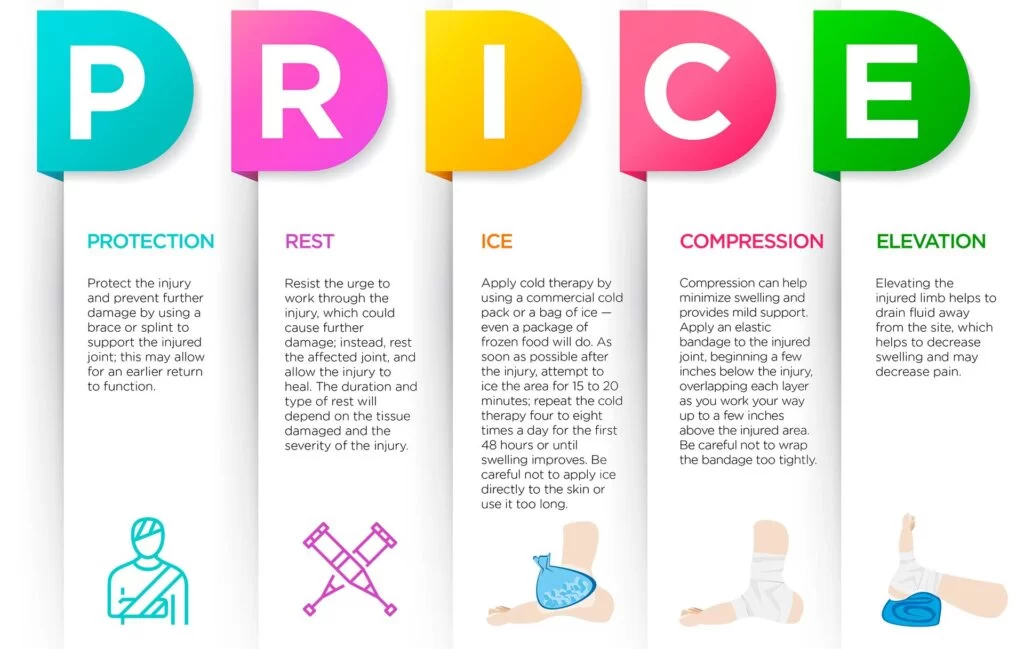
Medical treatment
In many cases of muscle pain, the doctor specifies anti-inflammatory and muscle relaxant medications.
When a doctor supposes this muscle pain is due to depression then he/she is suggested an anti-depressant medicine but not consume it for a long time.
An opioid is recommended for extreme pain but this medicine is also not advised for long periods (7-10 days).
You can also use pain relieving gel and spray like volini gel and spray on the site of muscle pain to remove muscle pain and swelling.
A trigger point injection is a direct shot of a powerful pain drug.
It benefits you and relieves muscle pain and swelling.
Physiotherapy treatment
When the muscle pain is not reduced after the home treatment and pain medication then the doctor has recommended physiotherapy treatment to reduce muscle pain.
Physiotherapy treatment is support you reduce pain, swelling, spasms, and tightness of muscle pain.
The physiotherapy treatment involves massage, electrotherapy treatment, and exercise therapy.
Massage:
When the trigger and tender points are present in the muscle pain site therapist is recommended to massage therapy reduce to the muscle pain.
Massage is used after 2 to 3 days of following the RICE principle when to feel to release of the pain.
Massage is used with the help of the oil and used for 5 to 10 min.
Massage is applied 3 times/day at home.
Electrotherapy treatment:
After the RICE principle, pain medication, and massage if the muscle pain is not reduced then utilized Electrotherapy treatment for the release of muscle pain.
To reduce the spasms, swellings, and pain therapist suggested to you electrotherapy treatment.
In electrotherapy, the treatment therapist is used to many appliances.
When the tender and trigger points are present therapists are suggested to apply ultrasound therapy (US) for the release of muscle pain.
Ultrasound: This treatment is applied with the help of gel and applies for 5-10 minutes on the site of pain.
This therapy helps you reduce swelling and pain.
Release to pain therapist is applied to short wave diathermy (SWD), Interferential Therapy (IFT), and Transcutaneous Electrical Nerve Stimulation (TENS) on the site of pain.
Short wave diathermy: SWD is hot therapy for reducing spam on the site of pain.
Interferential Therapy & Transcutaneous Electrical Nerve Stimulation: IFT and TENs are applied with the help of gel and electrodes on the site of pain.
This therapy is applied for 10 minutes to the site of pain.
Exercise therapy
After following the RICE principle for 2 to 3 days at home and primary treatment and the help of pain drugs, you feel released from the pain.
When you feel too relaxed and released from your muscle pain then the physiotherapist is suggested to you exercise therapy relieve to muscle tightness and weakness.
Exercise therapy for muscle pain involves stretching and strengthening exercises.
Strengthening Exercise helps you reduce muscle weakness as well as stretching exercise helps to reduce muscle tightness.
Strengthening Exercises:
After the follow of electrotherapy and massage for 2 to 3 days to free neck muscle pain by the therapist then the therapist is recommended to you do strengthening exercises for neck muscle weakness.
This strengthening exercise is always suggested when you feel to reduce pain and when you feel relaxed.
This all-strengthening exercise benefits you with muscle weakness and pain.
- Shoulder roll
- Chair rotation
- Lat pulldown
- Row
- Face pull
- Scapular squeeze
- Wall angel
- W retract
- Thoracic extension
- Reverse dumbbell
- Neck roll
- Reverse fly
- Shrugs
Shoulder roll:
The patient’s position is in standing with your arms down at your sides. And then roll your shoulders backward in a circular movement and perform 10 rotations, after that complete 5 rotations forward.
Do this exercise 10 times in 1 set and 3 sets/day.
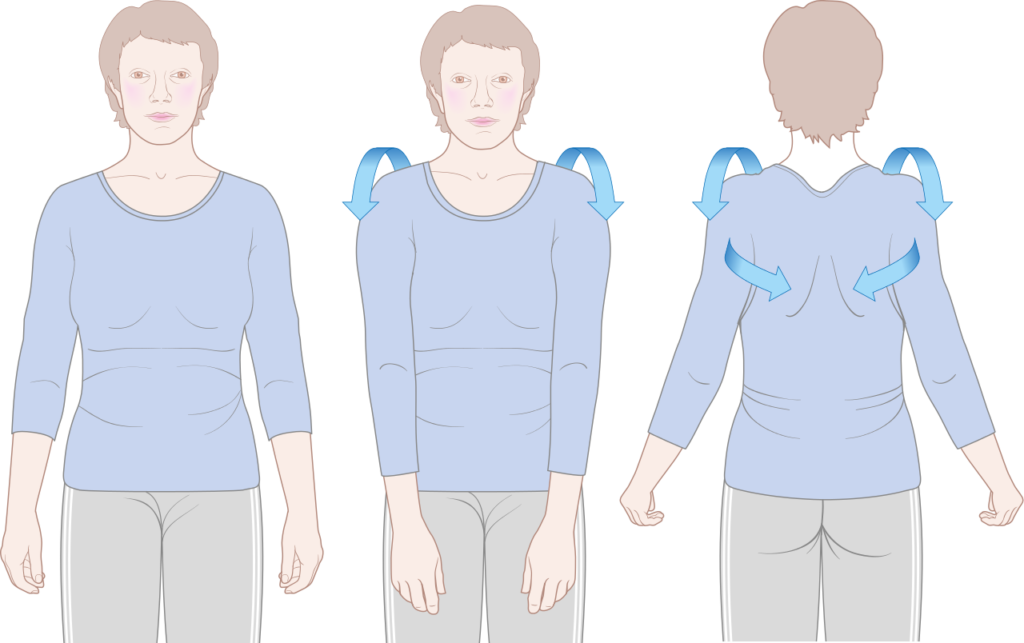
Chair rotation:
The patient’s position is in sitting sideways in a chair. Your good side is relaxing against the back of the chair.
Must maintain your legs stationary and rotate your torso to the right which is reaching for the back of the chair with your hands, try to maintain your upper body in rotation and use your arms to stretch deeper & deeper as your muscles relax.
Do this exercise 10 times in 1 set and 3 sets/day.
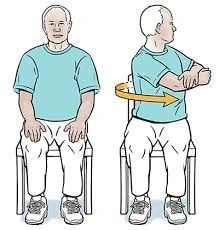
Lat pulldown:
The patient’s position is in sitting and standing and a resistance band is connected to a stable surface overhead, then try to Pull down on the band till your upper arms are parallel to the ground.
Maintain at the bottom and squeeze your legs and back to the starting position.
Do this exercise 10 times in 1 set and 3 sets/day.
Row :
For this exercise, we need a resistance band and a lightweight to medium-weight dumbbell.
First, connect the resistance band to a pole and another stable surface or grasp each handle, spreading your arms, then pull the handles straight back by flexing your elbow joint, and must be held the handle near to your body.
When you are using a dumbbell for this exercise keep the dumbbell in your right hand and brace yourself on a wall with your left hand then expanded the arm, then try to hinge at the waist to a 45-degree angle and allow the dumbbell to hang down.
Must hold your neck in a neutral position and your knee joint soft then pull the dumbbell directly up with a tucked elbow joint.
Do this exercise 10 times in 1 set and 3 sets/day.
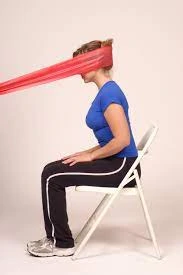
Face pull:
For this exercise also need a resistance band.
In starting, connect the band to a stable surface above eye level, then grab each handle with an overhand grip.
Then pull straight toward your face and flare your upper arms out to the sides or squeeze your shoulder joints together.
Maintain this for sometimes then back to the starting position.
Do this exercise 10 times in 1 set and 3 sets/day.
Scapular squeeze:
The patient’s position is in a standing position with her arms down by your side, then squeeze her shoulder blades together.
Maintain this exercise for 10 seconds, Do this exercise 10 times in 1 set and 3 sets/day.

Wall angel:
The patient’s position is in standing with her back flat against a wall.
You must require to step your feet out slightly to allow your back to fully soften against the wall, then extend your arms out and create a “T” shape against the wall and flex your elbow joint to create 90-degree angles, try to slowly move your arms up and down in a “snow angel” movement.
Must be provided that you stay flat against the wall the full time.
When your fingers touch above your head and back to the starting position.
Do this exercise 10 times in 1 set and 3 sets/day.
W retract:
the patient’s position is in a standing position and extends their arms up at an angle, then slowly pulls them down at a 90-degree angle and makes a W shape with the arms by retracting them to the stomach region.
Try to squeeze the shoulder blades and maintain for 10 counts.
Then relax and slowly back to the starting position.
Do this exercise 10 times in 1 set and 3 sets/day.
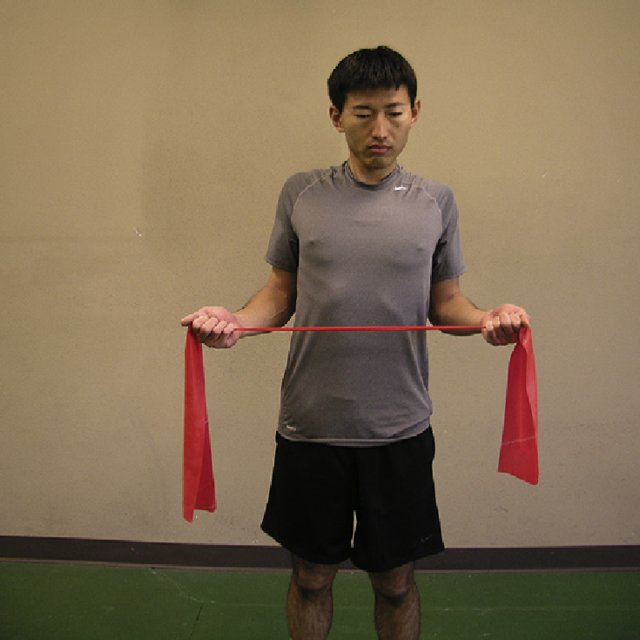
Thoracic extension:
In this exercise need a chair or foam roller.
The foam roller is put under your thoracic spine and then allows your head and glute muscles to fall on either side then raise your arms above your head to deepen the stretch.
With the chair, you sit facing forward and allow your upper body to fall over the back of the chair then extend your arms above your head for to deeper stretch.
Maintain in every position for 10 seconds and then relax.
Do this exercise 10 times in 1 set and 3 sets/day.
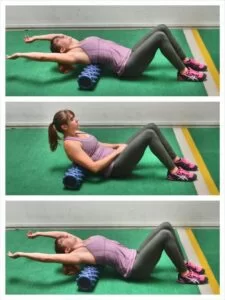
Neck roll:
The patient’s position is in standing and sitting facing forward for this exercise, then start with bending your neck to the right.
You feel the stretch via your neck to your trap muscle.
After some repetition gradually rolls your head counterclockwise, then maintain this exercise for 10 seconds
Repeat this 10 times on one side then repeat this exercise clockwise.
Do this exercise 10 times in 1 set and 3 sets/day.
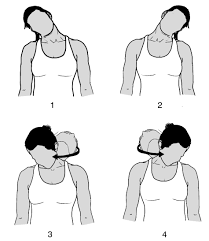
Reverse fly:
The patient’s position is in a standing position with a resistance band, then keep your elbow joint straight and pull your arms back.
Maintain your hands level at shoulder joint height and maintain this position for 10 seconds.
Do this exercise 10 times in 1 set and 3 sets/day.
Shrugs:
This exercise targets the trapezius muscles, and this exercise is done either by carrying light dumbbells and hand weights or also do without any weight.
Then Gently get your shoulder joint directly up to your ears.
Maintain this exercise for 10 seconds and slowly release.
Do this exercise 10 times in 1 set and 3 sets/day.
Stretching exercise:
After the follow of electrotherapy for 2 to 3 days to release muscle pain by the therapist, the therapist is suggested to stretch to reduce muscle tightness.
This stretching is used when your pain is reduced and when you feel comfortable.
- Levator scapulae stretch
- Upper trapezius stretch
- Trunk rotation
- Butterfly
- Overhead arm reach
- Child’s Pose
- Lat side stretches
- Wall stretch
Levator scapulae stretch:
The patient is in a standing position straight and sitting position in a chair.
Then try to rotate your neck 45 degrees to the left.
And then flex your neck downward.
You also use your one hand for a greater stretch.
Maintain this stretching position for 10 seconds.
Do this exercise 3 times in 1 set and 3 sets/day.
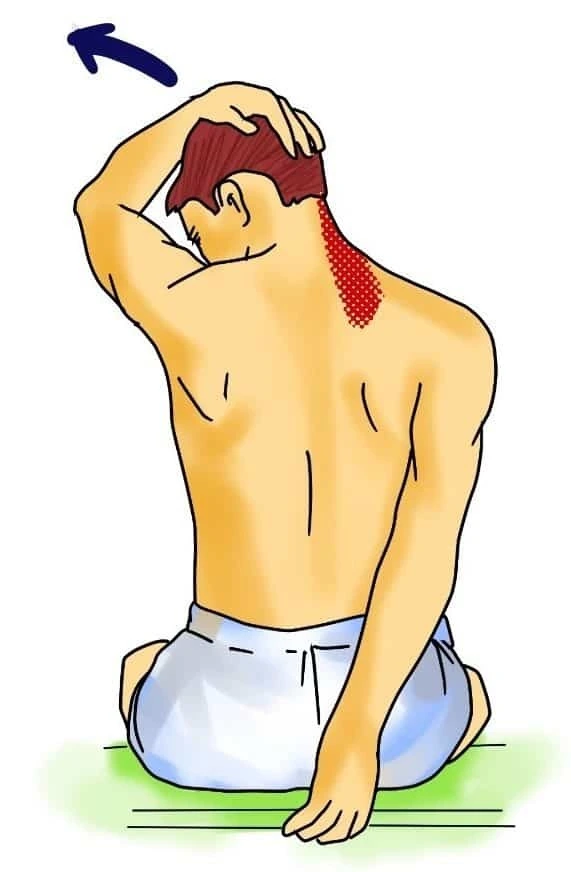
Upper trapezius stretch:
The patient is in a standing position straight and sitting position in a chair.
Take one hand and place the hand on the back of your head, and then try to take your other hand and tuck it behind your back.
You are using your right hand and gently pull your head toward your right shoulder joint.
Maintain this stretching position for 10 seconds.
Do this exercise 3 times in 1 set and 3 sets/day.
Trunk rotation:
The patient’s position is in lying on the back with the knee joint bent and the feet flat.
Must keep the knee joint flexed and gently turn them to the right side.
Maintain this stretching position for 5-6 seconds.
Then back the knee joint to the middle, and maintain this stretching position for 10 seconds.
Do this exercise 3 times in 1 set and 3 sets /day.

Butterfly:
The patient’s position is to place your palms on opposite shoulders and bring your elbow joints together to touch.
Maintain this for 10–20 seconds.
Do this exercise 3 times in 1 set and 3 sets/day.
Overhead arm reach:
The patient’s position is in a sitting or standing position, and they try to stretch the arms above the head.
Then bend to the right side and must keep both arms stretched upward.
To deepen the stretch, utilize the good hand to gently pull the left arm to the right.
After that back to the starting position.
Do this exercise 3 times in 1 set and 3 sets/day.

Child’s Pose:
The patient’s position is on the ground on all fours.
With your great toes touching spread your knee joints as far separated as go and sit your glutes back onto your feet.
You are sitting straight up with your arms stretched above your head.
Hinge at the waist level and lower your upper body forward between your legs.
Try to allow your forehead to touch the ground and your shoulder joint to spread and your glute muscle to sink back.
maintain this exercise for at least 10 seconds.
Do this exercise 3 times in 1 set and 3 sets/day.
Lat side stretches:
The patient’s position is in a standing position and with arms raised overhead.
Grasp the left wrist with the right hand.
Then gently bend to the right with a rainbow movement.
This stretch is administered by gently pulling on the wrist.
Maintain the stretching position for 10 seconds.
Do this exercise 3 times in 1 set and 3 sets/day.
Wall stretch:
The patient’s position is in standing with the right side of the body facing a wall and trying to flex the right arm at the elbow joint and placing the forearm against the wall.
The upper arm is straight so that the elbow joint forms at a 90-degree angle.
Gently take a step forward with the right foot and twist to the left.
Then allow the right shoulder joint and upper back to stretch.
Maintain this stretching position for 10 seconds and back to the starting position.
Do this exercise 3 times in 1 set and 3 sets/day.
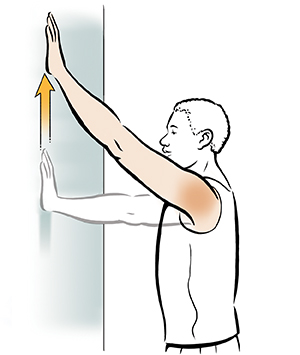
Surgical treatment for upper back muscle pain
After the medical treatment and physiotherapy treatment pain is not reduced then the doctor is recommended surgical treatment.
Surgery for upper back muscle pain is very irregular.
The surgery mainly includes thoracic spine injury.
Kyphoplasty or vertebroplasty :
This surgery enhances compression fractures due to osteoporosis.
Spinal decompression or spinal laminectomy :
When muscle pain is due to spinal stenosis your surgeon clears the bony walls of the vertebrae which are used to ease tension on the nerves.
Microdiscectomy :
When muscle pain is the cause of a disc bulges and presses on a nerve so the physician is recommended microdiscectomy means a minimally invasive reduction of a disc or part of a disc.
It is the gold standard method.
Prevention of upper back muscle pain
It is not possible to control all causes of upper back muscle pain, but some comfortable steps for prevention contain :
- Take to routine breaks from sitting and lying down to stretch and move to various muscle groups.
- Always take to regular breaks when you are working at a desk to stretch, so the muscles become to stay loose and strong.
- Always do a few minutes to stretch the muscles and do a warm-up of the body before any movements.
- If you are lifting weighty objects so must be avoided bending and lifting with the back.
- Do regular massages which help you to work out the stress of the muscles.
- During pain avoid sporting heavy backpacks and bags.
- Always follow a good posture like walking upright and sitting perfectly.
FAQ
How to treat muscular back pain?
The primary way to reduce a strain or minor injury is to take it easy for 24-72 hours. apply an ice pack & an over-the-counter pain reliever such as acetaminophen, aspirin, ibuprofen, or naproxen. After the inflammation relaxes down, a heating pad or pack can support and soothe muscles & connective tissue.
Will muscular back pain go out?
Acute, or short-term back each lasts a few days to a few weeks. Most low back pain is acute. It cares to determine on its own within a few days with self-care & there is no residual loss of function. In some circumstances, a few months are needed for the symptoms to disappear.
How know if back pain is muscular or skeletal?
A light ache when you move
A pulled muscle would not feel hot, tingling, or electric-like a painful nerve root would. The pain would only decrease while you are relaxed and resting, as the tension and spasms are relieved. Yet, the pain would most likely spread up when you get up to move again.
Is walking good for back muscle pain?
The simple move of walking is one of the best things we can do for chronic lower back pain. 10 to 15 minutes of walking double a day will help reduce lower back pain. Substitute this exercise for a more dynamic type of exercise if you prefer and/or are capable.
How long do back muscle aches last?
Most people’s back pain disperses in about a week or two, but if your pain is for a long time or chronic, it’s time to see a spine specialist.

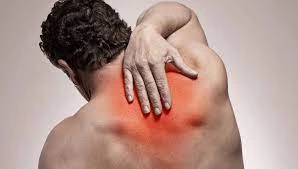
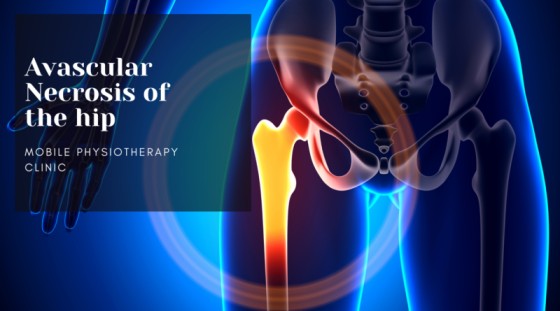
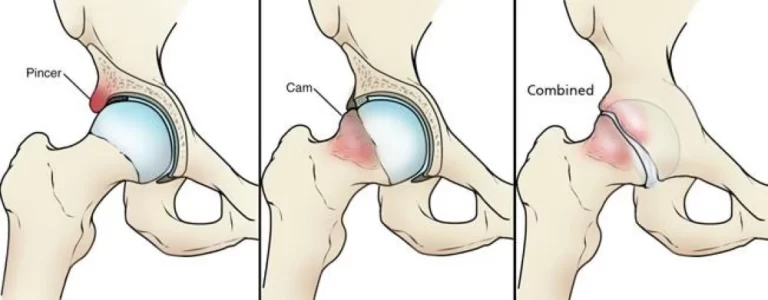
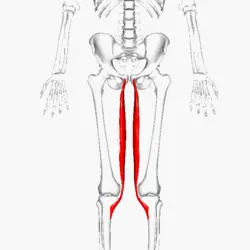
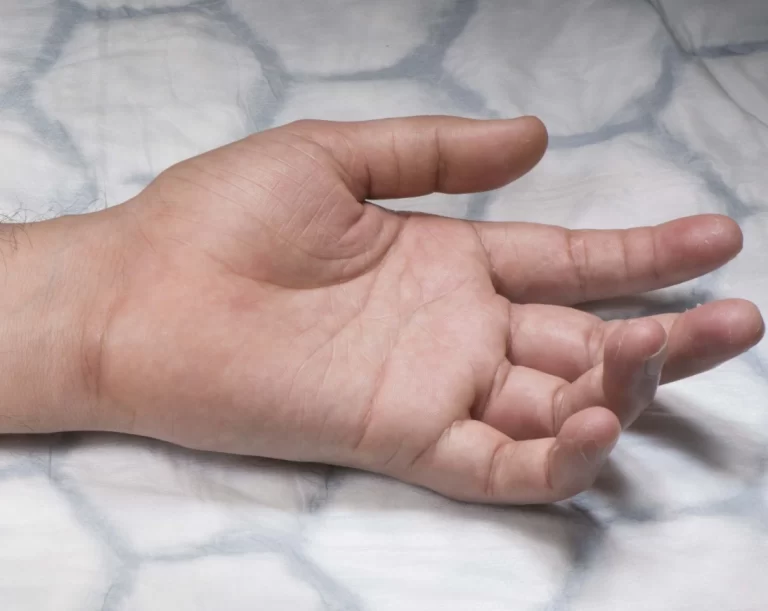
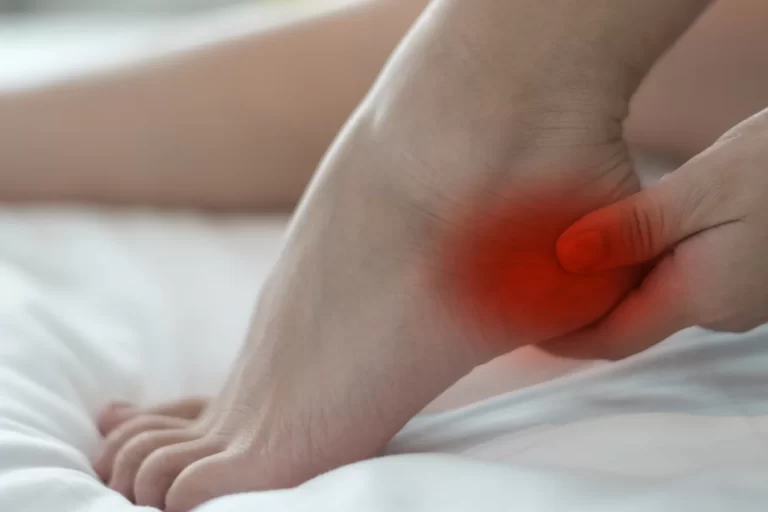
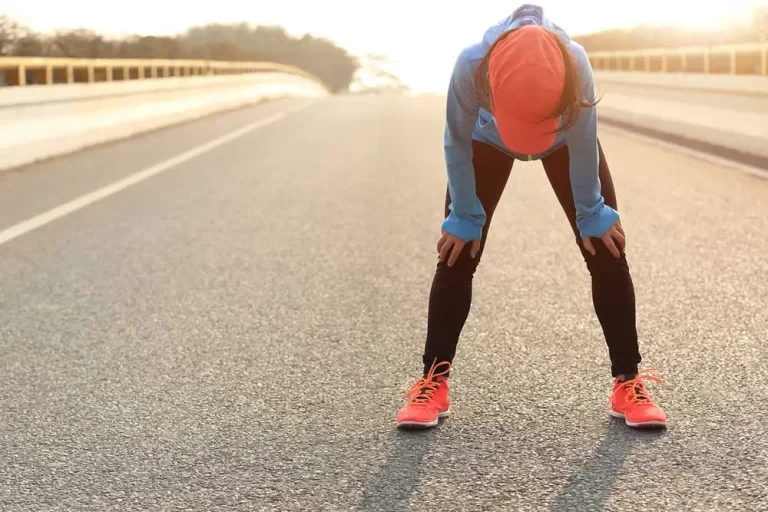
One Comment